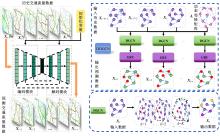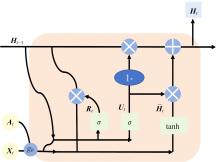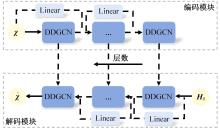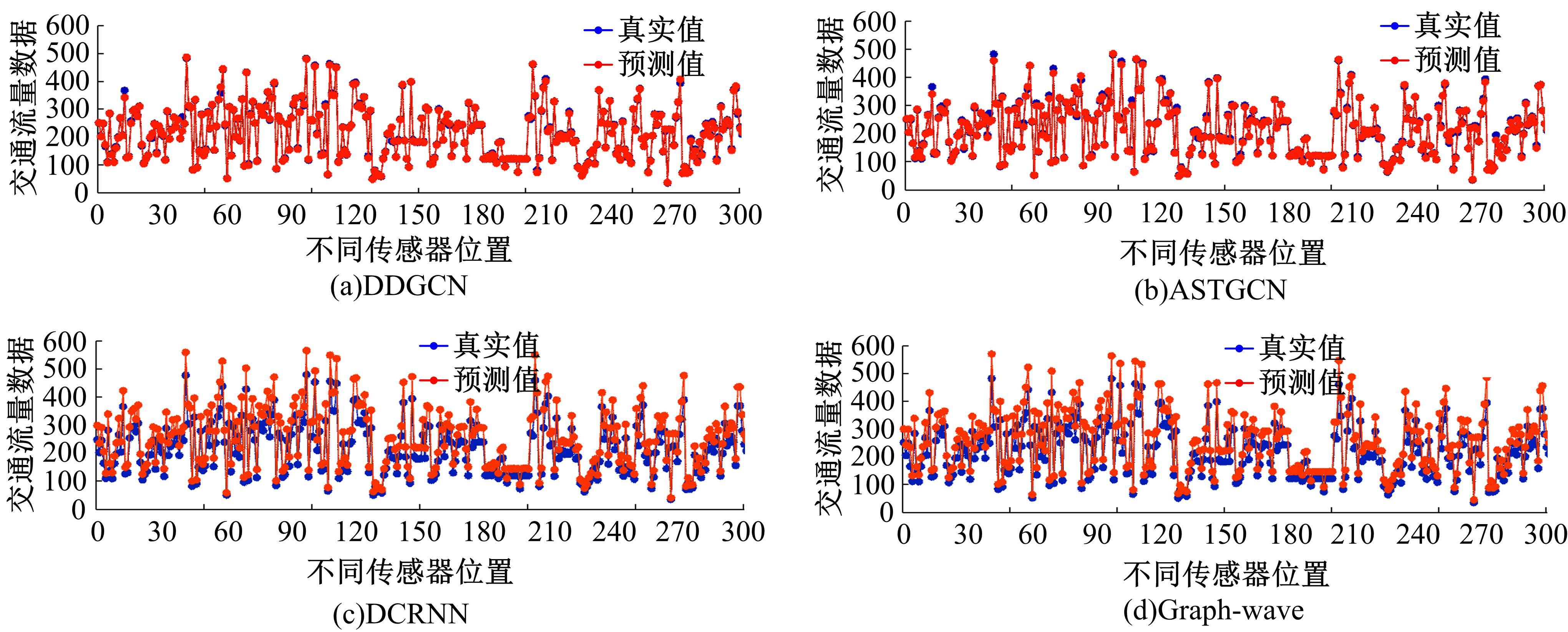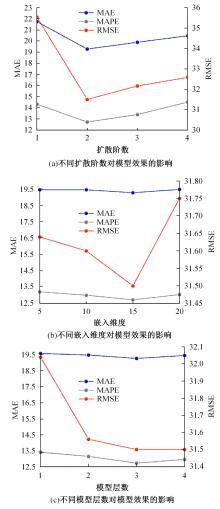Journal of Jilin University(Engineering and Technology Edition) ›› 2024, Vol. 54 ›› Issue (6): 1582-1592.doi: 10.13229/j.cnki.jdxbgxb.20220888
Traffic flow prediction algorithm based on dynamic diffusion graph convolution
Pei-guang JING1( ),Yu-dou TIAN1,Shao-chu WANG2,Yun LI3(
),Yu-dou TIAN1,Shao-chu WANG2,Yun LI3( ),Yu-ting SU1
),Yu-ting SU1
- 1.School of Electrical and Information Engineering,Tianjin University,Tianjin 300072,China
2.Tianjin Institute of Surveying and Mapping Co. Ltd. ,Tianjin 300072,China
3.College of Big Data and Artificial Intelligence,Guangxi University of Finance and Economics,Nanning 530001,China
CLC Number:
- TN18
| 1 | Li Y G, Shahabi C. A brief overview of machine learning methods for short-term traffic forecasting and future directions[J]. Sigspatial Special, 2018, 10(1): 3-9. |
| 2 | Vlahogianni E I, Karlaftis M G, Golias J C. Short-term traffic forecasting: where we are and where we're going[J]. Transportation Research Part C: Emerging Technologies, 2014, 43: 3-19. |
| 3 | Smith B L, Williams B M, Oswald R K. Comparison of parametric and nonparametric models for traffic flow forecasting[J]. Transportation Research Part C, 2002, 10(4): 303-321. |
| 4 | Zivot E, Wang J H. Vector autoregressive models for multivariate time series[EB/OL]. [2022-07-02]. |
| 5 | Williams B M, Hoel L A. Modeling and forecasting vehicular traffic flow as a seasonal ARIMA process: theoretical basis and empirical results[J]. Journal of Transportation Engineering, 2003, 129(6): 664-672. |
| 6 | Wu C H, Ho J M, Lee D T. Travel-time prediction with support vector regression[J]. IEEE Transactions on Intelligent Transportation Systems, 2004, 5(4): 276-281. |
| 7 | Lint H V, Hinsbergen C V. Short-term traffic and travel time prediction models[J]. Transportation Research Circular, 2012, 22(1): 22-41. |
| 8 | Yao H X, Wu F, Ke J T, et al. Deep multi-view spatial-temporal network for taxi demand prediction[C]∥International Conference on Artificial Intelligence, New Orleans, LA, USA, 2018, 32: 2588-2595. |
| 9 | Zhang C Y, Paul P. Long-term mobile traffic forecasting using deep spatio-temporal neural networks[C]∥International Symposium on Mobile Ad Hoc Networking and Computing, LA, USA, 2018, 231-240. |
| 10 | Guo S N, Lin Y F, Li S J, et al. Deep spatial-temporal 3D convolutional neural networks for traffic data forecasting[J]. IEEE Transactions on Intelligent Transportation Systems, 2019, 20(10): 3913-3926. |
| 11 | 苏育挺,王骥,赵玮,等.基于动态图卷积的图像情感分布预测[J].吉林大学学报: 工学版,2023,53(9):2601-2610. |
| Su Yu-ting, Wang Ji, Zhao Wei, et al. Image sentiment distribution prediction based on dynamic graph convolution[J]. Journal of Jilin University (Engineering Edition), 2023, 53(9): 2601-2610. | |
| 12 | Li Y G, Yu R, Shahabi C, et al. Diffusion convolutional recurrent neural network: data-driven traffic forecasting[C]∥International Conference on Learning Representations, Vancouver, Canada, 2018: 1-16. |
| 13 | Guo S N, Lin Y F, Feng N, et al. Attention based spatial-temporal graph convolutional networks for traffic flow forecasting[C]∥International Conference on Artificial Intelligence, Honolulu, Hawaii, USA, 2019, 33(1): 922-929. |
| 14 | Zhao L, Song Y J, Zhang C, et al. T-GCN: a temporal graph convolutional network for traffic prediction[J]. IEEE Transactions on Intelligent Transportation Systems, 2020, 21(9): 3848-3858. |
| 15 | Bai L, Yao L, Li C, et al. Adaptive graph convolutional recurrent network for traffic forecasting[C]∥International Conference on Neural Information Processing Systems, Virtual, 2020, 33: 17804-17815. |
| 16 | Wu Z H, Pan S R, Long G D, et al. Graph wavenet for deep spatial-temporal graph modeling[C]∥International Conference on Artificial Intelligence, Honolulu, Hawaii, USA, 2019: 1907-1913. |
| 17 | Li Z M, Lai D R. Dynamic network embedding via temporal path adjacency matrix factorization[C]∥International Conference on Information & Knowledge Management, Atlanta, GA, USA, 2022: 1219-1228. |
| 18 | Cho K, Merrienboer B V, Gulcehre C, et al. Learning phrase representations using rnn encoder-decoder for statistical machine translation[C]∥International Conference on Empirical Methods in Natural Language Processing, Columbia, Maryland, USA, 2014: 1724-1734. |
| 19 | Shuman D I, Narang S K, Frossard P, et al. The emerging field of signal processing on graphs: extending high-dimensional data analysis to networks and other irregular domains[J]. IEEE signal processing magazine, 2013, 30(3): 83-98. |
| 20 | Chen P, Sun Z Q, Bing L D, et al. Recurrent attention network on memory for aspect sentiment analysis[C]∥International Conference on Empirical Methods in Natural Language Processing, Copenhagen, Denmark, 2017: 452-461. |
| 21 | Chen J Y, Wang X K, Xu X H. Gc-lstm: graph convolution embedded lstm for dynamic link prediction[DB/OL]. [2022-07-02]. |
| 22 | Si C Y, Chen W H, Wang W, et al. An attention enhanced graph convolutional lstm network for skeleton-based action recognition[C]∥International Conference on Computer Vision and Pattern Recognition, Long Beach, California, USA, 2019: 1227-1236. |
| 23 | Fang Z, Long Q Q, Song G, et al. Spatial-temporal graph ode networks for traffic flow forecasting[C]∥ International Conference on Knowledge Discovery & Data Mining, Virtual, 2021: 364-373. |
| 24 | Choi J, Choi H, Hwang J, et al. Graph neural controlled differential equations for traffic forecasting[C]∥International Conference on Artificial Intelligence, Wien, Vienna, Austria, 2022, 36(6): 6367-6374. |
| 25 | Liu M H, Zeng A, Xu Z, et al. Time series is a special sequence: forecasting with sample convolution and interaction[C]∥International Conference on Neural Information Processing Systems, Orleans, Louisiana, USA, 2022: 1-18. |
| [1] | Fu-heng QU,Yue-tao PAN,Yong YANG,Ya-ting HU,Jian-fei SONG,Cheng-yu WEI. An efficient global K-means clustering algorithm based on weighted space partitioning [J]. Journal of Jilin University(Engineering and Technology Edition), 2024, 54(5): 1393-1400. |
| [2] | Shuai-shuai SUN,Chun-xiao FENG,Liang ZHANG. Path planning for multimodal quadruped robots based on discrete sampling [J]. Journal of Jilin University(Engineering and Technology Edition), 2024, 54(4): 1120-1128. |
| [3] | Zhi-gang JIN,Ren-jun SU,Xiao-fang ZHAO. Psychological assessment method based on heterogeneous graph network [J]. Journal of Jilin University(Engineering and Technology Edition), 2024, 54(4): 1078-1085. |
| [4] | Jing-peng GAO,Guo-xuan WANG,Lu GAO. LSTM⁃MADDPG multi⁃agent cooperative decision algorithm based on asynchronous collaborative update [J]. Journal of Jilin University(Engineering and Technology Edition), 2024, 54(3): 797-806. |
| [5] | Liu LIU,Kun DING,Shan-shan LIU,Ming LIU. Event detection method as machine reading comprehension [J]. Journal of Jilin University(Engineering and Technology Edition), 2024, 54(2): 533-539. |
| [6] | Yan-tao TIAN,Xing HUANG,Hui-qiu LU,Kai-ge WANG,Fu-qiang XU. Multi⁃mode behavior trajectory prediction of surrounding vehicle based on attention and depth interaction [J]. Journal of Jilin University(Engineering and Technology Edition), 2023, 53(5): 1474-1480. |
| [7] | Jian LI,Qi XIONG,Ya-ting HU,Kong-yu LIU. Chinese named entity recognition method based on Transformer and hidden Markov model [J]. Journal of Jilin University(Engineering and Technology Edition), 2023, 53(5): 1427-1434. |
| [8] | Hui-zhen ZHANG,Zheng-kai GAO,Jian-qiang LI,Chen-xi WANG,Yu-biao PAN,Cheng WANG,Jing WANG. Short⁃term passenger flow forecasting of urban rail transit based on recurrent neural network [J]. Journal of Jilin University(Engineering and Technology Edition), 2023, 53(2): 430-438. |
| [9] | Chun-hui LIU,Si-chang WANG,Ce ZHENG,Xiu-lian CHEN,Chun-lei HAO. Obstacle avoidance planning algorithm for indoor navigation robot based on deep learning [J]. Journal of Jilin University(Engineering and Technology Edition), 2023, 53(12): 3558-3564. |
| [10] | Tian BAI,Ming-wei XU,Si-ming LIU,Ji-an ZHANG,Zhe WANG. Dispute focus identification of pleading text based on deep neural network [J]. Journal of Jilin University(Engineering and Technology Edition), 2022, 52(8): 1872-1880. |
| [11] | Sheng-sheng WANG,Lin-yan JIANG,Yong-bo YANG. Transfer learning of medical image segmentation based on optimal transport feature selection [J]. Journal of Jilin University(Engineering and Technology Edition), 2022, 52(7): 1626-1638. |
| [12] | Hao-yu TIAN,Xin MA,Yi-bin LI. Skeleton-based abnormal gait recognition: a survey [J]. Journal of Jilin University(Engineering and Technology Edition), 2022, 52(4): 725-737. |
| [13] | Yong LIU,Lei XU,Chu-han ZHANG. Deep reinforcement learning model for text games [J]. Journal of Jilin University(Engineering and Technology Edition), 2022, 52(3): 666-674. |
| [14] | Long ZHANG,Tian-peng XU,Chao-bing WANG,Jian-yu YI,Can-zhuang ZHEN. Gearbox fault diagnosis baed on convolutional gated recurrent network [J]. Journal of Jilin University(Engineering and Technology Edition), 2022, 52(2): 368-376. |
| [15] | Zhi-hua LI,Ye-chao ZHANG,Guo-hua ZHAN. Realtime mosaic and visualization of 3D underwater acoustic seabed topography [J]. Journal of Jilin University(Engineering and Technology Edition), 2022, 52(1): 180-186. |
|
||
